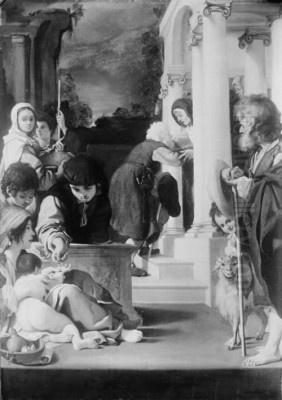
Bartolomeo Schedoni stands as a significant yet somewhat enigmatic figure in the transition from late Mannerism to the burgeoning Baroque period in Italy. Active primarily in Modena and Parma, his career, though tragically brief, produced works of remarkable emotional intensity and innovative use of light, leaving a distinct mark on the Emilian school of painting. Born in Modena in 1578 and dying in Parma in 1615, Schedoni navigated a path influenced by artistic giants while forging a style uniquely his own, all against the backdrop of a tumultuous personal life.
Early Life and Artistic Formation
Bartolomeo Schedoni entered the world in Modena in 1578. His origins were modest; his father, Giulio Schedoni, was a mask maker, serving the courts of both Modena and Parma. This connection to the courtly environment may have provided early exposure to the arts, although details of his initial training remain somewhat obscure. It is clear, however, that young Bartolomeo displayed considerable artistic promise from an early age.
His burgeoning talent did not go unnoticed. By 1595, his abilities had attracted the attention of Ranuccio I Farnese, the Duke of Parma. Recognizing Schedoni's potential, the Duke became a crucial patron, providing the young artist with a significant opportunity. He dispatched Schedoni to Rome, the vibrant heart of the Italian art world at the time, to further his education under the guidance of Federico Zuccari, a prominent Mannerist painter. This period in Rome, though perhaps brief, would have exposed Schedoni to a wealth of artistic currents, including the lingering influence of High Renaissance masters and the emerging revolutionary style of Caravaggio.
Following his Roman sojourn, Schedoni eventually settled in Parma, the city intrinsically linked with his ducal patron and the artistic legacy that would most profoundly shape his work. Parma, home to the masterpieces of Correggio, became the crucible in which Schedoni's mature style was forged. He remained largely based there, under the patronage of the Farnese court, until his untimely death.
Artistic Influences and Stylistic Development
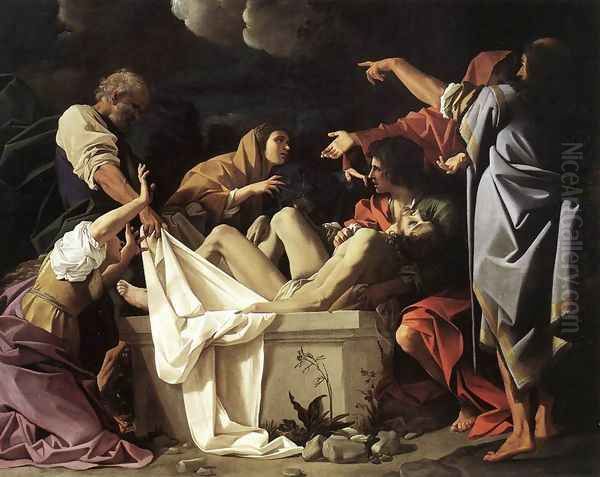
Schedoni's artistic identity was shaped by a confluence of powerful influences, synthesized into a distinctive personal style. Foremost among these was the legacy of Antonio Allegri da Correggio, the High Renaissance master whose works dominated Parma. Schedoni deeply absorbed Correggio's sensitivity to light, his sfumato technique, his tender rendering of figures, and his ability to convey profound emotion. Indeed, Schedoni's handling of soft, luminous light and intimate religious scenes led some later commentators to describe him as "Correggio reborn," highlighting the profound debt his art owed to the earlier master.
Alongside Correggio, the influence of the Carracci family – Annibale, Agostino, and Ludovico – was significant. Active in nearby Bologna and also influential in Rome, the Carracci spearheaded a reform movement away from the artificiality of late Mannerism towards a renewed naturalism, grounded in drawing from life and inspired by High Renaissance principles. Schedoni likely encountered their work both directly and indirectly, absorbing their emphasis on solid forms, clear narrative, and emotional directness. Some sources suggest potential, though debated, direct contact or study, possibly with Annibale Carracci in Bologna, or interactions with their circle, such as students mentioned by the biographer Carlo Cesare Malvasia.
A third major force impacting Schedoni, particularly evident in his later works, was Michelangelo Merisi da Caravaggio. Caravaggio's dramatic use of chiaroscuro (strong contrasts between light and dark) and his uncompromising naturalism were revolutionizing painting in Rome during Schedoni's formative years. While perhaps not a direct follower, Schedoni incorporated elements of Caravaggio's tenebrism and realistic depiction, especially visible in works like the Charity of St Elizabeth, blending it with the softer, more idealized grace derived from Correggio.
Schedoni also drew inspiration from the local artistic traditions of Parma itself, beyond Correggio. The elegant Mannerism of Parmigianino (Francesco Mazzola) and the works of Girolamo Mazzola Bedoli likely formed part of his visual vocabulary. His style, therefore, represents a complex fusion: the tenderness and light of Correggio, the structural solidity and reformed naturalism of the Carracci, the dramatic intensity of Caravaggio, and the lingering grace of the Parma school, all filtered through his own unique sensibility. His work is characterized by its rich, often warm color palette, dynamic compositions, powerful emotional resonance, and a masterful, often theatrical, manipulation of light and shadow – hallmarks of the Early Baroque.
Major Works and Themes
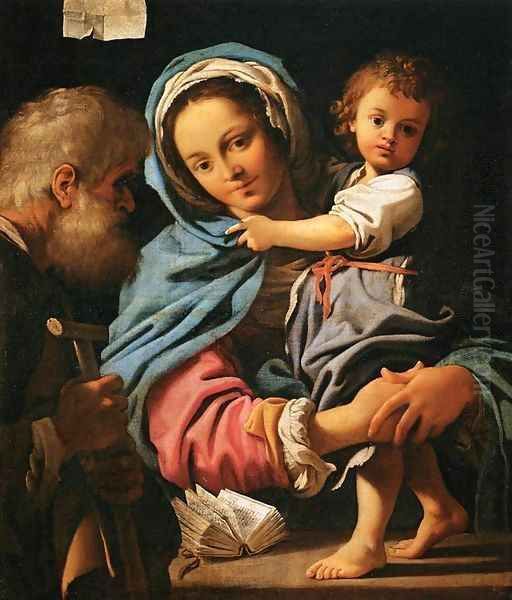
Bartolomeo Schedoni's oeuvre primarily consists of religious subjects, ranging from large-scale altarpieces to smaller, more intimate devotional paintings. His works were highly sought after by patrons, including the Farnese court. Many of his most important paintings are now housed in major European museums, including the Louvre in Paris, the Musée Ingres Bourdelle in Montauban, and the Musée Magnin in Dijon, as well as galleries in Italy, particularly Naples (where much of the Farnese collection ended up).
Among his representative works, several stand out. Paintings like the Lamentation over the Dead Christ (sometimes titled Deposition or Pietà with the Virgin and St John) showcase his ability to convey profound grief and pathos, using dramatic lighting to focus attention on the central figures. The Sleeping Christ with Mary and Joseph (or The Sleep of Jesus) exemplifies his Correggesque tenderness, depicting the Holy Family in a moment of quiet intimacy, bathed in soft, ethereal light.
The Holy Family was a recurring theme, allowing Schedoni to explore familial bonds and divine grace. A notable large altarpiece depicts The Holy Family in Glory worshipped by SS John the Baptist, Francis of Assisi, Lawrence and Peregrinus, demonstrating his skill in handling complex multi-figure compositions for public devotion. Another significant work is the Charity of St Elizabeth, which reveals a stronger Caravaggesque influence in its naturalistic portrayal of the poor and its dramatic use of light.
Allegorical subjects also appear, such as the Allegory of Christian Hope. Throughout these works, common threads emerge: a focus on human emotion, whether it be sorrow, maternal love, or divine ecstasy; a sophisticated use of light not just for illumination but for emotional and dramatic effect; and a rich, often jewel-toned color palette. His smaller religious images catered to private devotion, bringing the same intensity and refinement to a more intimate scale, often depicting the Madonna and Child with the Infant St John. These works collectively reflect the religious fervor of the Counter-Reformation era, emphasizing personal piety and the emotional impact of sacred narratives, while also showcasing the artist's technical brilliance and unique stylistic synthesis.
Interactions with Contemporaries
Schedoni's career unfolded during a vibrant period in Italian art, and he inevitably interacted with or was aware of the work of numerous contemporaries. His training under Federico Zuccari placed him initially within the orbit of late Roman Mannerism, though he quickly moved beyond it. His deep engagement with the works of Correggio, Parmigianino, and Girolamo Mazzola Bedoli situated him firmly within the artistic lineage of Parma.
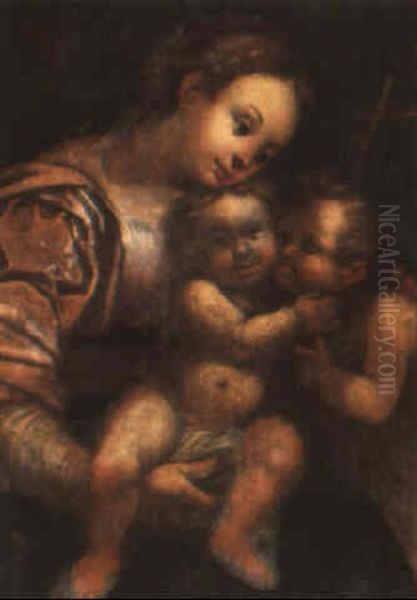
His relationship with the Carracci circle in Bologna is significant, even if the exact nature of his training remains debated. Whether through direct study with Annibale Carracci or simply through absorbing their influential style, their impact is undeniable. He would have been aware of their academy and their efforts to reform painting. His presence in Parma also coincided with the activity of other artists connected to the broader Emilian and Roman scenes.
Giovanni Lanfranco, another important Early Baroque painter who hailed from Parma and was heavily influenced by Correggio, was a contemporary. Records suggest they were both active in Parma during the same period, with Lanfranco undertaking significant commissions like altarpieces. It is plausible, even likely, that their paths crossed, and potential artistic exchanges or collaborations might have occurred, given their shared artistic heritage and geographical proximity.
The influence of Caravaggio, while perhaps indirect, connects Schedoni to the most radical artistic force of his time. He may not have been a direct "Caravaggista," but the impact of Caravaggio's naturalism and chiaroscuro is discernible, suggesting Schedoni was keenly aware of the latest developments emanating from Rome. Furthermore, stylistic similarities noted by some scholars between figures in Schedoni's work and those by Domenichino (Domenico Zampieri), a leading pupil of the Carracci active in Rome and Bologna, suggest Schedoni was part of the broader artistic dialogue of his generation, absorbing and responding to the innovations of his peers. His interactions, therefore, place him within a network that included Zuccari, the Carracci brothers (Annibale, Agostino, Ludovico), Correggio, Caravaggio, Parmigianino, Bedoli, Lanfranco, and Domenichino, among others.
A Turbulent Life and Mysterious End
Contrasting sharply with the sensitivity and refinement of his art was Bartolomeo Schedoni's notoriously turbulent personal life. Contemporary accounts and historical records paint a picture of a man prone to passion, conflict, and recklessness. His life was marked by episodes of violence and frequent clashes with the law. He was reportedly imprisoned on more than one occasion following disputes or brawls.
A significant factor contributing to his troubles was an apparent addiction to gambling. This passion for games of chance seems to have plagued him, leading to financial difficulties and potentially exacerbating his volatile temperament. His life seemed to oscillate between periods of intense artistic production for his patrons, particularly the Duke of Parma, and episodes of dissolute behavior.
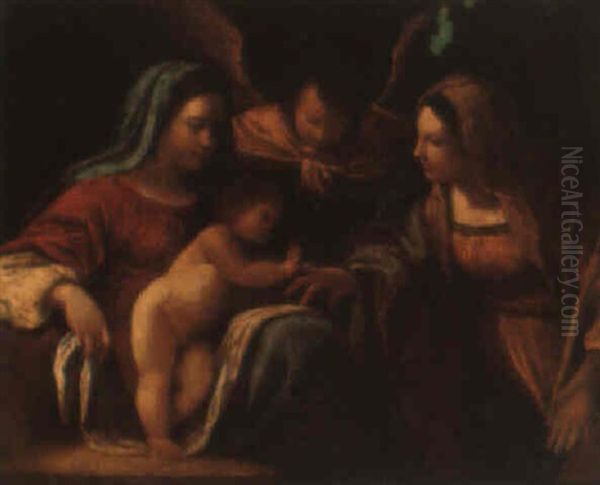
One peculiar anecdote relates to his love for the game of tennis (likely real tennis or jeu de paume). His enthusiasm for the sport was apparently so intense that it led to a severe injury or condition affecting his right hand, nearly costing him the ability to paint. This incident underscores the passionate, perhaps excessive, nature of his personality, extending even to his leisure activities.
The culmination of this troubled existence was his premature death in Parma in 1615, at the young age of 37. The exact circumstances surrounding his death remain somewhat unclear, but contemporary sources, including the biographer Malvasia, suggested the possibility of suicide. It was rumored that overwhelming gambling debts drove him to take his own life, a tragic end for such a gifted artist. While definitive proof is lacking, the narrative of a talented painter succumbing to his personal demons after a life of conflict and addiction has persisted, adding a layer of tragic mystique to his biography.
Legacy and Significance
Despite his short and troubled life, Bartolomeo Schedoni carved out a significant place in the history of Italian Baroque art, particularly within the Emilian school centered around Parma and Modena. His primary achievement lies in his unique synthesis of the major artistic currents of his time. He masterfully blended the soft luminosity and emotional tenderness of Correggio with the reformed naturalism and solid forms promoted by the Carracci, and incorporated the dramatic intensity and chiaroscuro pioneered by Caravaggio.
This fusion resulted in a style that was both deeply rooted in the traditions of Parma and forward-looking in its embrace of Baroque dynamism and emotionalism. He excelled in depicting intimate religious scenes imbued with genuine human feeling, rendered with a distinctive, often warm and glowing light. His altarpieces and smaller devotional works were highly valued and influenced subsequent painters in the region.
Schedoni represents a crucial link between the High Renaissance legacy in Parma and the full flowering of the Baroque. While overshadowed internationally by giants like Caravaggio or the Carracci, his work demonstrates the richness and complexity of artistic developments occurring outside the main centers of Rome and Bologna. His ability to absorb and personalize diverse influences, creating works of compelling beauty and emotional power, secures his importance.
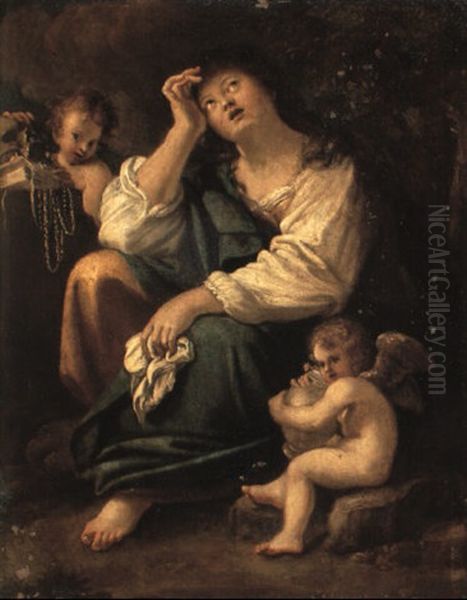
His paintings serve as powerful reflections of the Counter-Reformation's emphasis on personal piety and emotionally engaging religious art. They capture the era's spiritual intensity while showcasing a high level of technical skill and artistic innovation. The tragedy of his early death undoubtedly cut short a career that might have reached even greater heights, yet the body of work he left behind remains a testament to his exceptional talent and his unique contribution to the vibrant tapestry of Early Baroque painting in Italy. His legacy endures in the galleries that house his works and in the ongoing appreciation of his sensitive, luminous, and emotionally charged art.